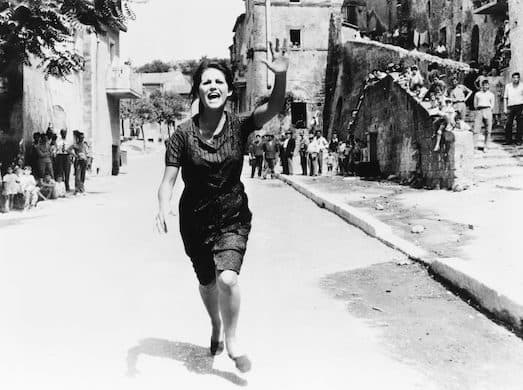Feel Claudia Cardinale’s Onscreen Presence as MoMA Runs a Retrospective
Those who need proof of Cardinale’s legitimacy as an actress will want to consider the auteurs who sought her talents: Frederico Fellini, Sergio Leone, Blake Edwards, Luchino Visconti, and Werner Herzog.

‘Claudia Cardinale’
Museum of Modern Art
February 3-21
Claude Joséphine Rose Cardinale, better known to the world as Claudia Cardinale, will be celebrating her 85th birthday come April.
Those of a certain age — that is to say, movie-goers who remember the striking figure Ms. Cardinale cut in films like “Rocco and His Brothers” (1960), “8-1/2″ (1963), “The Leopard” (1963), and as Princess Dahla in “The Pink Panther” (1963), the initial go-round for that particular franchise — will want to mark their calendars for the eponymous retrospective that the Museum of Modern Art has mounted in conjunction with Cinecittà, Rome. The series opens on February 3 and runs to the 21st.
Still, what might younger audiences think of Ms. Cardinale, an actress once heralded by her “Pink Panther” co-star, David Niven, as “Italy’s happiest invention” — that is, after spaghetti?
Niven’s Old World chauvinism notwithstanding, Ms. Cardinale doesn’t have quite the same hold on the popular imagination as, say, Sophia Loren or Audrey Hepburn. Although she’s garnered notice for her efforts on behalf of women’s rights in recent years — the actress was designated a Unesco goodwill ambassador in 2000 — Ms. Cardinale’s renown, in large part, rests on a type of glamor that is, if not at odds with 21st-century culture, then distinctly apart from it.
Then again, there are few people who are quite as multicultural as a native-French speaker who was deemed 1957’s “Most Beautiful Italian Girl in Tunisia.” Scoff all you want at the designation, but that oddly specific contest resulted in the young beauty queen traveling to Italy, whereupon she was offered a movie contract.
After a small part in “Goha” (1958), a vehicle for Omar Sharif, Ms. Cardinale had an eye-catching supporting role in “Big Deal on Madonna Street” (1958) playing Carmelina, the sister of a Sicilian criminal whose chief goal in life seems to be the protection of her chastity. You needn’t exert much brainpower to imagine just how diverting that plot point is in a comedy whose characters are predominated by scurrilous men.
“Claudia Cardinale,” curated by MoMA’s Joshua Siegel along with Cinecittà’s Camilla Cormanni and Paola Ruggiero, comprises 20 films, among a good dozen of them recent restorations. Cineastes who need proof of Ms. Cardinale’s legitimacy as an actress will want to consider the auteurs who sought her talents: Frederico Fellini, Sergio Leone, Blake Edwards, Luchino Visconti, and Werner Herzog. Ms. Cardinale is a resplendent starlet, sure, but she is also more than that.
Ms. Cardinale’s Italian successes and, not least, screen presence caught the eyes of Hollywood in the early to mid-1960s. Her spate of U.S. films are marked by compromises typical of the industry, but Ms. Cardinale remained sober-sided through it all: “I took care of my own interests, blankly refusing to sign an exclusive contract … I only signed for individual films.”
Her pictures stateside were a mixed bag, but not all of the results were disappointing. Ms. Cardinale’s favorite film during the American sojourn was “The Professionals” (1966), a robust Western in which she plays Maria, the wife of a wealthy American rancher (Ralph Bellamy) who is kidnapped by Jack Palance, the most unlikely of Mexican revolutionaries.
Ms. Cardinale’s character doesn’t show up until a full hour into the movie, but her youth and beauty make the surrounding veteran actors — not only Bellamy and Palance, but Lee Marvin, Burt Lancaster, Woody Strode, and Robert Ryan — seem all the more grizzled.
The same applies to “Once Upon a Time in the West” (1968), in which Ms. Cardinale’s character, a prostitute eager to return home to New Orleans, has to suffer the sexual advances of Henry Fonda, here famously playing against type. Does MoMA have a screen wide enough to accommodate director Sergio Leone’s operatic panoramas? Those who have seen the film know that “West” is epic any way you watch it.
Ms. Cardinale’s knack for comedy is seen to good effect in “Il magnifico cornuto” (“The Magnificent Cuckold”), a 1964 picture that makes swift work of male prerogative even as it allows for a bracing and, at times, unnerving lubriciousness. As the wife of a man whose philandering has caused him to doubt her devotion, Ms. Cardinale positively sparkles, bringing a worldly elan to what could have easily been a thankless or tawdry role.
Whenever Ms. Cardinale is on screen — even when she’s pitted against inveterate ham Tony Curtis in “Don’t Make Waves” — her presence can’t be denied. Thanks to MoMA for reminding us that movie stars still walk among us.

